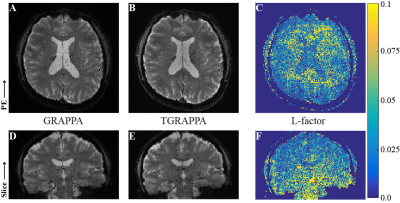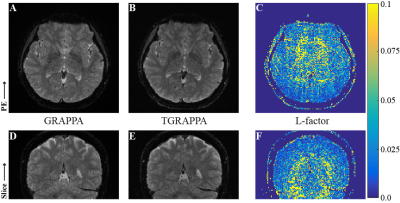3511
In-Plane Signal Leakage (L-factor) Maps from TGRAPPA1Laboratory for Cognitive Brain Mapping, RIKEN-Brain Science Institute, Wako-shi, Japan, 2Support Unit for Functional Magnetic Resonance Imaging, RIKEN-Brain Science Institute, Wako-shi, Japan, 3Siemens Healthcare KK, Tokyo, Japan
Synopsis
Residual aliasing is a well-documented problem for multiband reconstructions, but it can be an important issue with in-plane acceleration methods as well. With GRAPPA in particular, the residually aliased signal can be distributed fairy randomly, making it appear as g-factor noise. We demonstrate that the use of TGAPPA permits not only the elimination of the residually aliased signal but also the determination of L-factor maps, which can be a potentially useful tool in understanding how to minimize residual aliasing.
Purpose
Signal leakage due to residual aliasing in multiband EPI data has received considerable attention.1,2 While in-plane residual aliasing can be an issue as well, no method for determining leakage maps for in-plane acceleration methods has been presented to date. Kellman et al. pointed out that in a TSENSE acquisition (which is basically a multi-shot EPI acquisition with each shot reconstructed as a separate volume) the in-plane residually aliased signal is forced to have particular temporal frequencies, which can be easily filtered out.3 TGRAPPA4 uses the same acquisition strategy as TSENSE so this is true of TGRAPPA as well. Subtracting the filtered image from the unfiltered image, yields a residual alias or L-factor map for the TGRAPPA in-plane reconstruction. We present L-factor maps determined from EPI data reconstructed using TGRAPPA. L-factor maps could potentially be used to optimize both acquisition and reconstruction parameters, to minimize the residually aliased signal, which is true but misplaced signal. Minimizing the residually aliased signal, rather than discarding it, would provide an additional boost to tSNR.Methods
All experiments were performed on a 3T MAGNETOM Prisma (Siemens Healthcare, Erlangen, Germany), using a Siemens 32-channel head coil. EPI data were acquired from 2 healthy subjects (one female), average age 38 yrs. For each subject two EPI runs were acquired. One run was a standard product EPI sequence with 1.5 mm isotropic resolution, consisting of 10 volumes of 80 transaxial slices, with an FOV of 192x192x120 mm3, iPAT=4, TR=5.5s, and TE=30ms. The second run was multi-shot EPI with the same resolution and coverage as the first run. This run was acquired in 4-shots with a shot TR of 5.5s. Both runs used a bandwidth of 890Hz/pixel. Each shot of the multi-shot dataset was reconstructed offline using a TGRAPPA reconstruction scheme (in-house code), resulting in a 40-volume dataset with a volume TR of 5.5s. In both GRAPPA and TGRAPPA reconstructions, a 4x3 GRAPPA kernel was used.
The last step in the TGRAPPA reconstruction is to apply a temporal notch filter that removes the Nyquist frequency and 0.5*Nyquist frequency. These are the frequencies that the residually aliased signal oscillates at in an iPAT=4 TGRAPPA acquisition. L-factor maps are determined by subtracting a filtered TGRAPPA image from its corresponding unfiltered image and normalizing by the filtered images, as shown in Equation 1. The subscript i denotes voxels in the image volume.
$$L-factor_{i}=\frac{\mid TGRAPPA(unfiltered)_{i}-TGRAPPA(filtered)_{i}\mid}{TGRAPPA(filtered)_{i}}\quad\quad\quad[1]$$
Results & Discussion
Fig. 1 A&D show example GRAPPA images for Subject A and Fig. 1 B&E show TGRAPPA images. By visual inspection it can be seen that the TGRAPPA images are less noisy, especially toward the middle of the brain and for the lower slices. Fig. 1 C&F show L-factor maps for this subject. From the L-factor maps it can be seen that the residual aliasing can be more that 10% of the filtered signal in many areas. While the regions in the L-factor map of high residual aliasing show some structural features in this dataset, the aliasing is largely incoherent, illustrating why the residually aliased signal in the GRAPPA images can be easily mistaken for g-factor noise.
Fig. 2 shows example results for Subject B. The L-factor maps have similar features to the L-factor maps for subject A, though the locations of high residual aliasing do not appear to coincide well between the two subjects. This suggests that the residual aliasing patterns are not purely a function of coil sensitivities, but also include session specific and/or subject specific factors.
The motivation for the original development of TGRAPPA and its predecessor TSENSE was to improve reconstructions in the presence of subject motion. With normal GRAPPA or SENSE, the misalignment between the calibration data and the data being reconstructed results in both increased and time varying residual aliasing. Thus, the residual aliasing contributes to the deterioration of both image SNR and tSNR. While the TGRAPPA filter removes the residually aliased signal, an important improvement, the L-factor maps can be a useful tool in optimizing the acquisition strategy to minimize the residual aliasing as well.
Conclusions
Residually aliased signal is present in in-plane accelerated reconstructions, just as in slice accelerated reconstructions. For GRAPPA reconstructions, this residually aliased signal can be distributed in such a way as to make it appear more like g-factor noise than aliased signal. The use of TGRAPPA not only provides cleaner reconstructions, by filtering out the residually aliased signal, it allows for the determination of L-factor maps, which can be useful tools in optimizing acquisition strategies, thus keeping signal where it should be rather than throwing it away.Acknowledgements
This work was partially funded by a grant from the Brain/MINDS project.References
- Cauley, S.F., Polimeni, J.R., Bhat, H., Wald, L.L., Setsompop, K., Interslice leakage artifact reduction technique for simultaneous multislice acquisitions. Magn Reson Med 2014; 72: 93–102.
- Moeller, S., Xu, J., Auerbach, E.J., Yacoub, E., Yacoub, E.S., Ugurbil, K., Signal Leakage(L-factor) as a measure for parallel imaging performance among simultaneously multi-Slice (SMS) excited and acquired signals. ISMRM 2012; 20:519.
- Kellman, P., Epstein, F.H., McVeigh, E.R., 2001. Adaptive sensitivity encoding incorporating temporal filtering (TSENSE). Magn Reson Med 2001; 45:846–852.
- Breuer, F.A., Kellman, P., Griswold, M.A., Jakob, P.M., 2005. Dynamic autocalibrated parallel imaging using temporal GRAPPA (TGRAPPA). Magn Reson Med 2005; 53:981–985.
Figures

